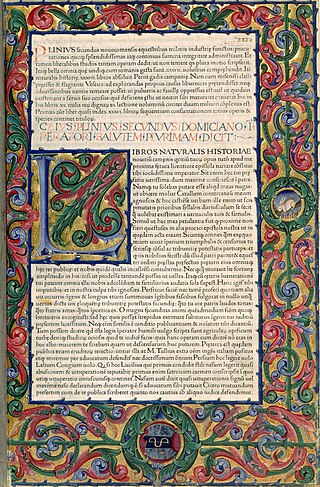Naturalis historia may refer to:
Pliny may refer to:

The Natural History is a Latin work by Pliny the Elder. The largest single work to have survived from the Roman Empire to the modern day, the Natural History compiles information gleaned from other ancient authors. Despite the work's title, its subject area is not limited to what is today understood by natural history; Pliny himself defines his scope as "the natural world, or life". It is encyclopedic in scope, but its structure is not like that of a modern encyclopedia. It is the only work by Pliny to have survived, and the last that he published. He published the first 10 books in AD 77, but had not made a final revision of the remainder at the time of his death during the AD 79 eruption of Vesuvius. The rest was published posthumously by Pliny's nephew, Pliny the Younger.

A table of contents, usually headed simply Contents and abbreviated informally as TOC, is a list, usually found on a page before the start of a written work, of its chapter or section titles or brief descriptions with their commencing page numbers.
Natural history is the scientific study of plants or animals.
History is the study of the past.

Atarneus, also known as Atarna (Ἄταρνα) and Atarneites (Ἀταρνείτης), was an ancient Greek city in the region of Aeolis, Asia Minor. It lies on the mainland opposite the island of Lesbos. It was on the road from Adramyttium to the plain of the Caicus. Its territory was called the Atarneitis.
In Greek mythology, the name Anthus may refer to:
Historia Naturalis may refer to:
In Greek mythology, Chios may refer to two possible eponyms of the island of Chios:

In Greek mythology, Methe is the spirit and personification of drunkenness. She entered the retinue of Dionysus and was mentioned in association with the god or other companions of his. Methe was the daughter of Dionysus in some accounts.
The Marsaci or Marsacii were a tribe in Roman imperial times, who lived within the area of the Rhine–Meuse–Scheldt delta, under Roman domination.
In Greek mythology, the name Hyperbius may refer to:
In Greek mythology, Arabius or Arabus may refer to the following distinct or identical individuals:
Aristarete or Aristareta was an ancient Greek painter. Little is known about her, including where and when she lived.
The Adunicates were a small Gallic tribe dwelling in the upper Durance valley during the Roman era.
The Nemeturii or Nemeturi were a Gallic tribe dwelling in the Alpes Maritimae during the Iron Age.
The Ucennii,Ucenni or Iconii were a Gallic tribe dwelling in the Romanche valley, in the Alps, during the Iron Age.
The Vergunni were a Gallic tribe dwelling in the valley of the Riou, near the Verdon river, during the Iron Age.
The Gallitae were a Gallic tribe dwelling in the upper valley of the Bléone river (Alpes-de-Haute-Provence) during the Iron Age.
The Nemaloni were a Gallic tribe dwelling in the middle valley of Durance river during the Iron Age.